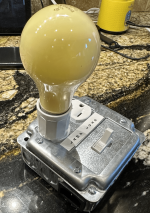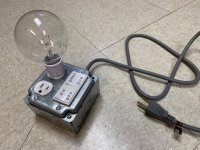In the process of @ItsAllInMyHead mentoring me in building an Aleph J, the concept of a Dim Bulb Tester came up. I did a quick search in the forum but thought it might be helpful to any other dim bulbs out there to post what I found. I like the idea of having a switched outlet so I ordered this, and for the socket. Other than that, a 3 conductor power cord, 1 end cut off, and a work box for the outlet, super easy peasy. Add to that maybe 3 different wattage incandescent light bulbs and for about $15-$20 a nice way to test and possibly save an Oops!
If you are going to be building, I would invest in a variac. Its not, without a little experience an absolute replacement,
but it is when properly used, especially if you pre test your power supplies before hooking them up to amp. After you have built a few,
you get to trusting the power supply you built, I still pre test them.
Once proven and hooked up, you can slowly ramp up voltage just like on an old electric train set! Just keep an eye out, an IR thermometer
out and look for anything funny as you ramp up. My wall voltage is about 120, so if all going well take it up to 90 volts and let it set. You will also note when your uotputs are coming on, watch bias, like voltage keep low until full voltage. Then after some warming, bring up bias while adjusting offset.
Having extra fuses, one in each leg will allow you to work one side at the time even though amp is completely wired.
First couple of turn on I do with variac, once stable lower bias a touch, remove variac and plug in wall. power up, let warm fully, adjust up bias to where you want it to be, recheck few times, now just another amp...
You cant meaningfully adjust anything with dim bulb, its just a fail safe that will save amp in event of mistake. Proving power supply first will get you a long way in that respect, then the slow upping of wall voltage while monitoring saves the rest...
but it is when properly used, especially if you pre test your power supplies before hooking them up to amp. After you have built a few,
you get to trusting the power supply you built, I still pre test them.
Once proven and hooked up, you can slowly ramp up voltage just like on an old electric train set! Just keep an eye out, an IR thermometer
out and look for anything funny as you ramp up. My wall voltage is about 120, so if all going well take it up to 90 volts and let it set. You will also note when your uotputs are coming on, watch bias, like voltage keep low until full voltage. Then after some warming, bring up bias while adjusting offset.
Having extra fuses, one in each leg will allow you to work one side at the time even though amp is completely wired.
First couple of turn on I do with variac, once stable lower bias a touch, remove variac and plug in wall. power up, let warm fully, adjust up bias to where you want it to be, recheck few times, now just another amp...
You cant meaningfully adjust anything with dim bulb, its just a fail safe that will save amp in event of mistake. Proving power supply first will get you a long way in that respect, then the slow upping of wall voltage while monitoring saves the rest...
I have used a variac for all my new builds; starting at 90 Vac, then slowly ramping up to 115 Vac. Once the initial bias and DC offset are adjusted, let everything cool down, then plug directly into wall AC (120 Vac), and burn in for at least one hour, double checking bias and offset after.
A bulb tester can be a useful tool, but new tungsten filament bulbs are getting harder to find. I do have a stash going back many years, but others may find them difficult to source in the different wattages needed for different load testing.
A bulb tester can be a useful tool, but new tungsten filament bulbs are getting harder to find. I do have a stash going back many years, but others may find them difficult to source in the different wattages needed for different load testing.
I’ve been using mine from Circuit Specialists for years…it’s a great investment, along with a bench power supply to pretest all your new circuits, prior to final installation.If you are going to be building, I would invest in a variac.
Sold my diy built dimbulb tester a while back (The yellow bulb I got from McMaster-Carr):

Like Russell says, it’s fine for your first few projects, after that…variac!
Best
Anand.
Thanks @Russellc, your input is most welcome, and I think that I can see a variac in my future. This was somewhat geared toward people with limited experience and skill sets. The guide, which is outstanding, for the upcoming Aleph J says, of course you've tested your PS, so I thought I would be proactive when they are available.
Since my name was mentioned above, I feel like it should be mentioned... I have strongly recommended a variable transformer over and above a dim bulb tester if someone needed to only pick one. However, it's very nice to have both, and if a variable transformer is out of the budget or ... then a DBT is better than nothing.
Well @chrisng just swooped in while I was typing this up and pretty much blew up the point I was gonna make comparing DBT vs Variac, but I figured I'd share since I went to all the work looking the parts for a DBT you can plug into on Amazon.
6ft 3-prong cord - $10
Dual gang metal junction box - $7
Tamper Proof Outlet - $1.50
Single Pole Switch - $2
Wire Nuts - $0.25
Electrical tape - essentially zero
A12 dual prone bulb adapter plug - $6
E12 to A19/E26 adapter - $5
25W Incandescent bulbs E12 base (12 pack) - $12
40W Incandescent oven bulbs A19 base (4 pack) - $8
60W Incandescent bulbs E12 base (12 pack) - $12
100W Incandescent bulbs A19 base (2 pack) - $15
150W Incandescent bulbs A19 base (4 pack) - $17
Total for DBT (w/ 25/60/100/150W bulbs above) - $87.75
20A Variac - $77
Depending on how many different bulb wattage you buy and knowing you'll want a few on hand for those times they do what they are intended for in a DBT (protection), it ends up a Variac is possibly the cheaper tool. Point is great to have both, but overall, they really are near equal cost due to needing multiple bulbs in multiple voltages.
Makes more sense to go with @chrisng version of DBT if budget is the driver as it looks like the cost is about $10 plus bulbs. Still, bulb cost adds up.
6ft 3-prong cord - $10
Dual gang metal junction box - $7
Tamper Proof Outlet - $1.50
Single Pole Switch - $2
Wire Nuts - $0.25
Electrical tape - essentially zero
A12 dual prone bulb adapter plug - $6
E12 to A19/E26 adapter - $5
25W Incandescent bulbs E12 base (12 pack) - $12
40W Incandescent oven bulbs A19 base (4 pack) - $8
60W Incandescent bulbs E12 base (12 pack) - $12
100W Incandescent bulbs A19 base (2 pack) - $15
150W Incandescent bulbs A19 base (4 pack) - $17
Total for DBT (w/ 25/60/100/150W bulbs above) - $87.75
20A Variac - $77
Depending on how many different bulb wattage you buy and knowing you'll want a few on hand for those times they do what they are intended for in a DBT (protection), it ends up a Variac is possibly the cheaper tool. Point is great to have both, but overall, they really are near equal cost due to needing multiple bulbs in multiple voltages.
Makes more sense to go with @chrisng version of DBT if budget is the driver as it looks like the cost is about $10 plus bulbs. Still, bulb cost adds up.
Last edited:
100% in favor of dim-bulb testing on every power up of all new equipment. It's passive, and because it requires no interpretation or action, the DBT will save your bacon more than a variac. (Which is also something you should have... but get the DBT first.)
You can find them fairly reasonable, but not the cheapest thing either. For straight up beginners, who can identify parts and solder/desolder well yet have no clue what they are building, it's a good, and inexpensive way to save your amp from failure.Since my name was mentioned above, I feel like it should be mentioned... I have strongly recommended a variable transformer over and above a dim bulb tester if someone needed to only pick one. However, it's very nice to have both, and if a variable transformer is out of the budget or ... then a DBT is better than nothing.
I most recently used variac on XA 252 fire up. I tested the power supply first, then discharged it. I knew it was functioning correctly.
Putting fuses in one side, meter on bias and off set. At about 90 volts on variac, puck mosfets turned on and bias began to register. Keeping bias low as voltage increased then once stable at 120 on variac set bias about 3/4, touched up offset, and let Cook. After cook, reset both and run for next couple evenings still with variac.
Once it is just setting stable, turn down is a touch and power down. Plug into wall sans variac, power up , once hit touch up
The bulb deal will save your amp from mis wires and so forth, but can't use it during adjustment like with variac.
I still haven't done the lab power supply! Also resisting O'scope and associated learning curve. Both are necessary really.I’ve been using mine from Circuit Specialists for years…it’s a great investment, along with a bench power supply to pretest all your new circuits, prior to final installation.
Sold my diy built dimbulb tester a while back (The yellow bulb I got from McMaster-Carr):
View attachment 1298849
Like Russell says, it’s fine for your first few projects, after that…variac!
Best
Anand.
Mine has a amp meter, but it has never worked!The best is a Variac with an ampmeter. Still needs active control by the user however. That fuse holder idea is great when there is one!
Not since brand new. There's probably a switch or wire not connected. Needle has never moved!
- Home
- Amplifiers
- Pass Labs
- Aleph J Dim Bulb Tester Post
